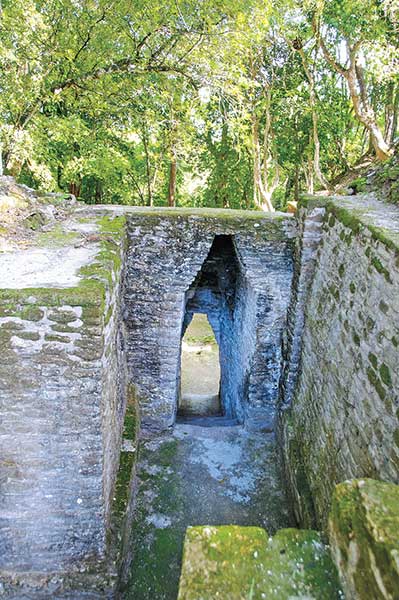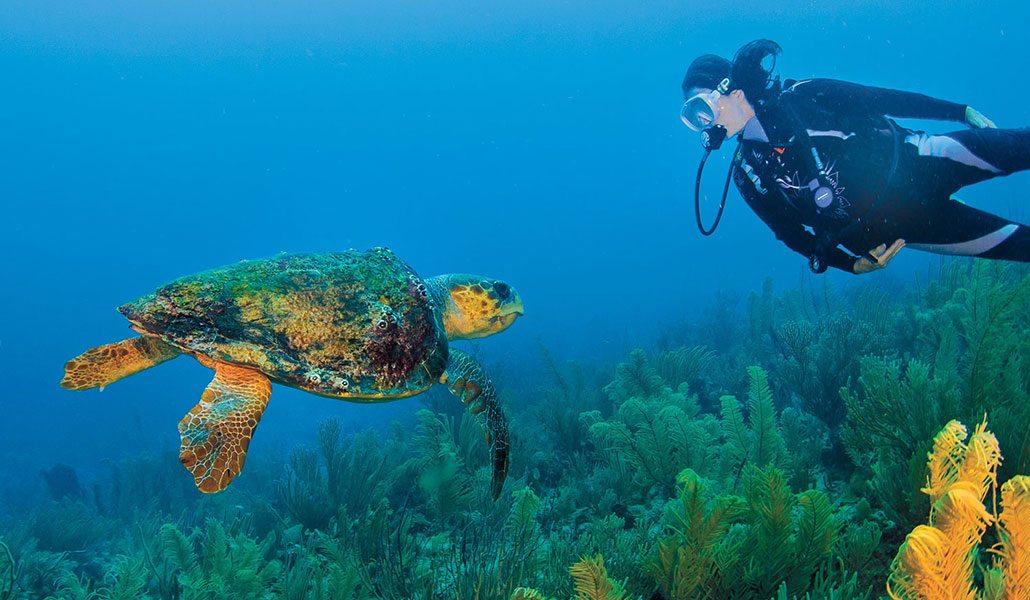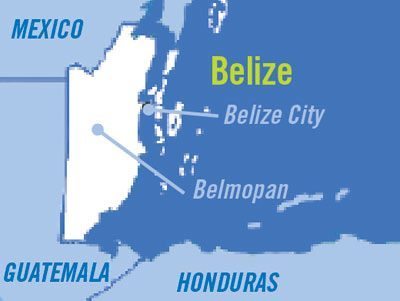Belize is an enchanting Central American country overflowing with the wonders of nature. Its rich biodiversity has played a major role in bringing this small country from relative obscurity to the forefront as one of Central America’s exciting destinations for eco-tourism. Whether by land or by sea, vacationers will find countless opportunities to participate in activities such as cave tubing, kayaking, ziplining, horseback riding or bird-watching. Or, you may choose to hike or join a guided tour through one of the many sanctuaries or reserves to enjoy nature’s kaleidoscope of incredible flora and fauna. Mysteries of the Mayan ruins also attract visitors eager to learn more about the fascinating history of this ancient culture. The Barrier Reef, the largest in the Western Hemisphere and a UNESCO World Heritage Site, provides an underwater world of amazing beauty for scuba divers and snorkelers to explore. With all that Belize has to offer, it is easy to understand why eco-tourism is instrumental in the growth and popularity of Belize.
 Centuries of Change
Centuries of Change
Belize is known as the Heartland of the Maya for good reason. The Maya were the first recorded inhabitants in Belize with an estimated population of 1 million. Numerous ruins have been excavated across the country, revealing the life and times of these intriguing people; many more ruins are yet to be discovered. Today’s culture continues to reflect Mayan heritage throughout Belize.
Columbus was the first European to travel to Belize in 1502, followed by English settlers and Caribbean slaves after the demise of the Mayan civilization in the 17th century. The first settlement was established in 1638 on St. George’s Caye. One of the largest settlements on the mainland, Belize City, was built at the mouth of the Belize River. For the next 150 years, the settlements continued to grow. As a result, Belize is the only Central American country to have a British history.
The 17th and 18th centuries were troubled times for the small territory. Countries such as Guatemala and Spain were fighting for control of the land, and pirates preyed on Spanish ships. Despite it all, English settlers remained, and stayed loyal to England. In 1840, the country became the Colony of British Honduras. In 1862, England recognized Belize as a Crown Colony. In January 1864, Belize was granted full self-government under a ministerial system of government. In 1973, the country’s name was changed from British Honduras to Belize, and on September 21, 1981, Belize gained full independence from Britain.
Geographic Diversity
Belize includes a pleasant mix of mainland and offshore geography, with more than 200 cayes and three atolls, most of which are inside the Barrier Reef Reserve. Six districts represent different areas on the mainland: Corozal, Orange Walk, Belize, Cayo, Stann Creek and Toledo. The cayes vary in size, ranging from about 25 miles (40 km) long to only a few hundred feet. Because Belize has the lowest population density in Central America, wide-open spaces of pristine, untouched natural treasures are plentiful; this rich biodiversity is one of the country’s main attractions. Belize rests atop a limestone shelf, creating an extensive honeycomb of underground caves. To the north, the landscape is a mix of coastal mangroves, pine forests and lush jungles. In central and southern areas, the Maya Mountains dominate the scenery as they extend northward 70 miles (112 km) from the Guatemalan border. These stunning mountains are a tropical paradise of rivers, caves and rain forests inhabited by exotic animals such as jaguars, tapirs, monkeys and kinkajous. Green tree frogs, crocodiles and other reptiles are also found in this diverse paradise. Along the coastline, mangrove trees send their tangled web of roots into the water, creating a haven for wildlife and marine nurseries. The barrier reef creates a beautiful and diverse environment for the underwater world. Belizeans are proud of their country’s natural beauty and have taken giant steps to keep it pristine. Currently, 40 percent of the land is protected through the creation of land and marine reserves.
Diving the Barrier Reef
The reef running parallel to the mainland is part of the Mesoamerican Reef system stretching from South America to Cozumel. Eight to 16 miles (13-26 km) separate the mainland from the open ocean, resulting in less land and human pollution and a healthier, more pristine seascape. Most of the reef’s flora and fauna are similar, with miles of hard and soft corals, beautiful gorgonians, sea fans and barrel sponges painting the reef with a variety of rainbow colors. Large areas of the reef are relatively flat; other areas include sloping walls and large, steep walls.
On the lee side of the reef, exquisite snorkeling and dive sites are plentiful. It’s home to more than 500 species of fish and marine life, and divers often have a chance to see French angels, schools of gray angels and spotted eagle rays gracefully swimming through the water. Spiny lobsters hiding in the cracks and hawksbill turtles slowly cruising among the colorful sponges always capture a diver’s attention.
Dive sites are sprinkled along the barrier reef from Ambergris Caye to Sapodilla Cayes Marine Reserve. During April and May, the full and new moon phases bring thousands of groupers together to spawn; large schools of dog, cubera and mutton snappers also spawn during this time, bringing in whale sharks to feed. The feeding ritual commonly occurs off Placencia near Gladden Spit. Whale shark trips are available; lucky divers may be able to snorkel with these majestic, gentle giants.
The famous, iconic Blue Hole draws divers and snorkelers by the hundreds. Formed more than 10,000 years ago, the formation was a cave until the top caved in, creating a large hole 400 feet (121 m) deep with visibility of about 100 feet (30 m). Sharks and parrotfish are commonly seen in this unusual dive site.
The small island of South Water Caye is perched on top of the barrier reef, surrounded by a kaleidoscope of marine life living on the healthy coral reefs, sand flats and mangrove nurseries. Due to South Water Caye’s incredible biodiversity, Belize has placed a marine biology station and lodge on the island for researchers and students to study marine life. Park fees are collected by the Fisheries Department to help support the management of the marine reserve. South Water Caye, a habitat for the threatened West Indian manatee, is also listed as a World Heritage Site.

A Mix of Cultures and Adventures
Visitors to Belize will discover a country of friendly, warm people who welcome them to their homeland. More than 320,000 inhabitants represent a melting pot of more than eight colorful cultures, each with their own customs and traditions. The Maya were the first settlers, followed by a variety of other cultures, including the English, Creole (African/European mix), Mestizo (Spanish/Maya), Hispanic, Garifuna (African/Carib), Mennonites and East Indians. In recent years, many Chinese and Taiwanese have migrated to Belize as have retired ex-pats from the United States, Canada and Europe.
The cuisine in Belize is as varied as the cultures. Inspired by the Creole, the national dish is rice and beans flavored with coconut milk. Fried plantain is a staple, as are meat pies and fry jacks — fried dough often filled with meat and cheese. Coconut milk is a popular ingredient in many local dishes.
Adventures are plentiful for visitors of all ages. One of the most interesting pursuits is exploring Mayan sites. Tours through ruins are amazing as well as educational, especially when guided by Maya descendants who often share the history of their heritage. With more than 500 species of birds in Belize, birding is a popular endeavor, especially at the Crooked Tree Wildlife Sanctuary where birders see many brightly colored birds in their natural habitat. Hiking through the lush-green jungles offers visitors a close look at the diversity of plant life and exotic wild life, and caving can be especially adventuresome for athletic types. Some caves, decorated with stunning stalactites, stalagmites and Mayan artifacts, present a chance for cave tubing, swimming or even rappelling through certain areas.
Canoeing on the Macal and Mopan rivers is always an enjoyable adventure. Flyfishing is exhilarating, especially when seeking the grand slam — catching bonefish, permit and tarpon. The catch-and-release policy is strictly enforced so please abide by the rules. Many reserves, sanctuaries and national parks are waiting to be explored. Areas range from the beautiful Belize Botanical Gardens on the banks of the Macal River to the Cockscomb Basin Wildlife Sanctuary in the Maya Mountains. When the sanctuary is combined with the Bladen Nature Reserve, more than 400,000 acres are opened up for endangered jaguars to roam freely, along with howler monkeys, ocelots, tapirs and birds such as the scarlet Macaws. Marine reserves offer many underwater adventures for divers and snorkelers.
Districts
The largest city in the Belize District, Belize City, served as the capital until it was virtually destroyed by Hurricane Hattie in October 1961. In 1970, the capital was moved inland to Belmopan in the Cayo District to protect against future storms. Belize City continues to be the principal port as well as the primary industrial and commercial center. Tourists will enjoy historical sites such as St. John’s Cathedral, the oldest Anglican cathedral in Central America, built in 1812. A performing arts center, art exhibitions and the Museum of Belize display various aspects of the country’s history. Numerous duty-free shops selling gifts and souvenirs are located in the Belize Tourism Village. Downtown also has gift shops as well as wood carvers and street artists. Most of this area is between the Tourism Village and the swing bridge, the oldest manually operated bridge in the world still in operation. Near Belize City, history buffs will enjoy a visit to the Altun Ha Mayan Ruins where a famous 10-pound (4.5 kg) jade head was discovered.
The Corozal District in northern Belize has its share of Mayan history; the best-excavated site open to the public is Santa Rosa, located in Corozal Town. In the Orange Walk District, one of the main attractions is the Lamanaia Archaeological Reserve. The reserve, surrounded by 2 square miles (5.2 sq km) of forest, is one of the largest ceremonial sites in Belize.
The largest district is Cayo, home to Belmopan, the capital of Belize. Located along the Western Highway one hour from Belize City, the town is teeming with activity. Small shops, restaurants and a central market selling locally grown citrus crops keep visitors happily busy. The scenic area surrounding Belmopan is a showcase of nature, with waterfalls, caves and a jungle that is home to Belize’s wildlife. Cayo is also home to three of the most spectacular ruins in Belize: Xunantunich, Cahal Pech and Caracol. Located in the Chiquibul Forest Reserve, Caracol is the largest-known ruin in Belize; more than 35,000 buildings have been discovered to date. Caana, a massive 140-foot (42 m) pyramid with three temples, is the tallest man-made structure in Belize.
The twin towns of San Ignacio and Santa Elena on the western edge of Cayo are separated by the Macal River; the one-lane suspension Hawksworth Bridge connects the two towns. The towns are buzzing with tourists enjoying the sights by day and the exciting nightlife in the evenings. The well-known ruin, Xunantunich (Maiden of the Rock), is 12 miles (19 km) west of the twin towns. To reach the ruins, visitors much cross the river on a hand-cranked ferry. Only the more athletic visitors should attempt the 130-foot (39 m) climb to the top of El Castillo. A view from the top of the pyramid provides an amazing panoramic view of Guatemala to the west and Cayo to the East.
When visiting San Ignacio, we were able to visit the Cahal Pech ruins dating back to 1200 B.C. Having explored other ruins such as Tulum and Coba in Mexico and Altun Ha in Belize, we were eager to visit a ruin still being excavated. To date, a royal tomb and hundreds of pottery pieces have been uncovered; also excavated is a 77-foot (23 m) pyramid off the central plaza with a series of passageways leading to interior courtyards. Other halls dead-end into small rooms with stone beds or small altars. The hallways, some with an arch, lead to more hallways and stairs with numerous 90-degree turns much like a maze. As we quietly walked through the small passages, we could almost hear the echoes of Mayan royalty who walked these halls hundreds of years before us, dressed in robes of tropical feathers and adorned with gold and jade jewelry.
The Stan Creek District is home to the seaside town of Dangriga, the district capital and cultural center of the Garifuna, which contains most of the area’s population. The Garifuna live in wooden homes on stilts surrounded by coconut palms, mango trees and the Maya Mountains to the West.
The newest tourist attraction is Placencia, located on the tip of an 11-mile-long (18 km) peninsula. The village is believed to be one of the oldest in Belize, founded in the 1600s by British buccaneers. A three-mile-long (4.8 km) golden sand beach curves along the coastline; the Placencia Lagoon, filled with colorful marine life, is near the beach. Placencia is a quaint town with a laid-back attitude. The locals are friendly, outgoing and delighted to welcome vacationers to their little piece of paradise. Main Street, considered the town center, is really not a street at all. Main Street is simply a 3- to 4-foot-wide (0.9 to 1.2 m) cement sidewalk extending a mile (1.6 km) through small shops, woodcarvers, artists and restaurants. Just north of the town, large homes are now under construction, reflecting the growth of tourism in the area.
Traveling from Belize along Hummingbird Highway and Southern Highway leads to the remote district of Toledo, home of Punta Gorda and the Lubaantun ruins, one of the last Mayan cities built before the collapse of the Maya civilization. Punta Gorda, the last main town in Belize, is nestled between the Maya Mountains, Guatemala Mountains, the Caribbean and the Bay of Honduras. This incredible setting is also home to half of Belize’s Maya population; they cultivate crops, carve exquisite mahogany and rosewood bowls, and weave the famous Jippi Jappa baskets treasured by tourists.
Island Celebrations
Belize’s national calendar is filled with cultural celebrations and national holidays throughout the year. The biggest national celebration is Independence Day held on September 21. People across the country throw one giant party to commemorate their independence. Street parades, music and dancing are only a few of the ways the Belizeans celebrate this special day. One of the largest festivals in Belize is on Ambergris Caye where San Pedro hosts the annual International Costa Maya Festival with cultural and musical performers. In the Corozal and Orange Walk districts, the Mestizo culture is celebrated on Pan Am Day. Beauty contests and exciting fiestas provide a day of fun for participants. November 19 is Garifuna Settlement Day, marking the day in 1832 when Garifuna ancestors arrived in Dangriga. National holidays such as New Year’s Day, Christmas and Boxing Day are also observed.
Traveling throughout the country, visitors will also experience a kaleidoscope of cultures, captivating diving in the Caribbean and stunning biodiversity on land — all of which create the true essence of Belize. Yes, Belize may be small in size, but it packs a big punch as Central America’s blossoming vacation destination.
Story and photos by Ruth and Barry Guimbellot
For More Information: www.travelbelize.org






